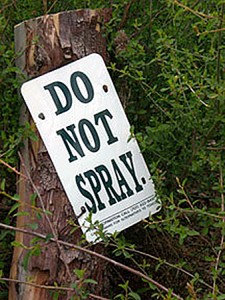(Beyond Pesticides, July 27, 2010) Groups filed a lawsuit in federal court to force the Environmental Protection Agency (EPA) to decide whether or not it will cancel all remaining uses and tolerances for the pesticide chlorpyrifos, which has been banned for residential use, but continues to expose farmworkers and consumers through its use in agriculture. In September 2007, the Natural Resources Defense Council (NRDC) and Pesticide Action Network North America (PANNA) filed a petition with EPA asking the agency to ban chlorpyrifos. In the nearly three years since, the agency has not responded. NRDC and PANNA v. EPA, filed by the nonprofit environmental law firm Earthjustice on July 22, 2010, would force EPA to make a decision on the pesticideâs ban.
âThis dangerous pesticide has no place in our fields, near our children, or on our food,â said Earthjustice attorney Kevin Regan. âWeâre asking a court to rule so that EPA will finish the job and ban this poison.â
According to Beyond Pesticides, EPA’s 2000 negotiated settlement with Dow AgroSciences, which allows the highest volume chlorpyrifos uses to continue, represents a classic failure of the risk assessment process (including the so-called cumulative risk assessment which accounts for all chemicals with the same mechanism of toxicity) under the Food Quality Protection Act (FQPA) –a failure that is repeated over and over again in agency chemical regulation decisions.
Advocates have pointed to chlorpyrifos as the poster child for why risk assessment does not work to protect the public, workers and the environment, even with safer practices and products available in the marketplace. EPA’s decision in 2000 and subsequent action removed chlorpyrifos’ residential uses and retains all agricultural uses except tomatoes (allowable residues on apples and grapes were adjusted), golf course and public health mosquito spraying. The agency argued at the time of its decision that it had adequately mitigated risks through the removal of high exposure uses to children in the residential setting, but ignored the special risks to farmworker children’s exposure as well as the availability of alternative agricultural practices and products that made chlorpyrifos unnecessary and therefore its risks unreasonable. The decision at the time was hailed as a victory for the public because it eliminated high hazard exposures and showed that EPA could remove uses of a widely used chemical. Except, it did not do the job. The risk assessment process does not force a consideration of those who suffer disproportionate risk or groups of people (such as those with neurological dieases in this case who are disproportinately affected). Farmworker groups and Beyond Pesticides, represented by Earthjustice, sued the agency but failed to move the litigation forward on a procedural issue.
Chlorpyrifos is a neurotoxic insecticide whose use was found to exceed acceptable rates of illness, especially to children. By focusing on risk reduction strategies to come up with “acceptable” (but in Beyond Pesticides’ view unnecessary) rates of illness across the population, EPA virtually ignored the chemical’s widespread use in agriculture (with one exception that focused on dietary residues), resulting in exposure to farmworkers, farm families and others living near agricultural areas. It is also a frequent water contaminant and a long range contaminant, exposing communities and contaminating pristine areas far from where it was applied. Short term effects of exposure to chlorpyrifos include chest tightness, blurred vision, headaches, coughing and wheezing, weakness, nausea and vomiting, coma, seizures, and even death. Prenatal and early childhood exposure has been linked to low birth weights, developmental delays and other health effects. A Harvard University study links exposure to organophosphate pesticides like chlorpyrifos to attention deficit hyperactivity disorder (ADHD). EPA has literally had information on chlorpyrifos’ adverse effects for decades.
âThe overwhelming evidence shows that chlorpyrifos is dangerous, especially to children and fieldworkers,â said Aaron Colangelo, a senior attorney with NRDC. âThereâs no good reason for EPA to take three years to decide what to do about it.â
Chlorpyrifos is used widely on corn, orchard, and vegetable row crops all over the country. While it is known to contaminate dozens of fruits and vegetables with detectable residues, Beyond Pesticidesâ Eating with a Conscience database reveals that chlorpyrifos is also registered for use on more than half of the 15 âcleanestâ fruits and vegetables, or those with the lowest pesticide residues (asparagus, cabbage, corn, grapefruit, kiwi fruit, onion, peas and sweet potatoes). So while there may be little residue remaining by the time it reaches your store shelf, these crops may be grown with hazardous pesticides that get into waterways and groundwater, contaminate nearby communities, poison farmworkers, and kill wildlife, while not all showing up at detectable levels on our food. An estimated 8 to 10 million pounds of chlorpyrifos are applied to U.S. crops each year (see a U.S. Geological Survey map showing where chlorpyrifos is used.)
Luis Medellin has experienced the dangers of this pesticide firsthand. Medellin lives with his parents and three little sisters in the agricultural town of Lindsay, California, where chlorpyrifos is sprayed routinely on the orange groves surrounding his home. During the growing season, the family is awakened several times a week by the sickly smell of nighttime pesticide spraying. What follows is worse: searing headaches, nausea, vomiting. After undergoing testing for pesticides in his body, the 24-year-old Medellin discovered concentrations of chlorpyrifos breakdown compounds nearly five times the national average for adults, as calculated by the Centers for Disease Control and Prevention.
âWhen I found out I had this chemical in my body, it scared me. But what really worries me is how my little sisters might be affected.â said Mr. Medellin, a community organizer with the Lindsay-based El Quinto Sol. âI wish the growers would stop using such dangerous chemicals so my family and I can be safe.â
Exposure to chlorpyrifos in agricultural communities is widespread. California Air Resources Board monitoring in the stateâs San Joaquin Valley detected chlorpyrifos in one-third of all ambient air samples, sometimes at levels that pose serious health risks to young children. Monitoring by PANNA and community groups in Washington state and Luis Medellinâs hometown of Lindsay, California has shown that daily exposure to chlorpyrifos can be substantial, regularly exceeding the âacceptableâ 24-hour acute dose for a one-year-old child established by the EPA. In one 2000 incident, dozens of students and staff at an elementary school in Ventura, CA fell ill after chlorpyrifos applied to a nearby lemon orchard drifted onto school grounds.
âChlorpyrifos is among a class of pesticides that targets developing nervous systems — in insects and humans alike. These pesticides are linked to a host of devastating diseases ranging from ADHD to childhood brain cancer,â said PANNA senior scientist Margaret Reeves, PhD. âTheir human health costs are just too high and farmers are farming successfully without them. There’s no defensible reason for continuing to use chlorpyrifos.â
This is the second lawsuit aimed at banning chlorpyrifos uses that remained on the market following the 2001 residential use cancellations. UFW et al. v. EPA was filed in federal district court July 31, 2007 by Earthjustice, Farmworker Justice, Natural Resources Defense Council, and California Rural Legal Assistance, on behalf of farmworkers, farmworker advocacy organizations and Beyond Pesticides. The lawsuit was dismissed on a technicality after the pesticide industry successfully argued in a related case that the lawsuit should have been filed in appellate court, rather than district court. The plaintiffs disagreed with the logic of the argument, but accepted the dismissal and pursued other options.
Beyond Pesticides advocates for the national conversion to organic sytems planning, which moves chemicals off the market quickly and replaces them with green management practices. The chlorpyrifos story, in addition to untold damage it has caused families across the U.S., is testimony to the need to adopt alternatives assessments that force chemicals off the market that can be replaced by safer or green practices. Despite agency efforts to use failed risk assessment decision making to claim that the food supply is safe and the environment protected, an informed public is driving the growth of organic production in the marketplace, choosing health and environmental protection over risk assessment. It is a process that can be supported through purchasing decisions everyday in the grocery store and advocacy that effects a conversion of land and building management in parks, schools, lawns and gardens, health care facilities, indoor and outdoor spaces to nontoxic and least-toxic methods. Whether it is agriculture, schools, lawns and gardens, health care facilities, or community insect management, turn to Beyond Pesticides for the latest on science, policy, safe management practices, and activism.
 Links to pesticide exposure are being found in a growing number of studies that evaluate the causes of preventable diseases –including asthma, autism and learning disabilities, birth defects and reproductive dysfunction, diabetes, Parkinsonâs and Alzheimerâs diseases, and several types of cancer. A new database, released today, tracks published epidemiologic and real world exposure studies. The studies challenge the effectiveness of risk-assessment-based regulation which is intended to manage adverse disease outcomes, but is criticized for allowing the uses of chemicals that can be replaced by green technologies and practices.
Links to pesticide exposure are being found in a growing number of studies that evaluate the causes of preventable diseases –including asthma, autism and learning disabilities, birth defects and reproductive dysfunction, diabetes, Parkinsonâs and Alzheimerâs diseases, and several types of cancer. A new database, released today, tracks published epidemiologic and real world exposure studies. The studies challenge the effectiveness of risk-assessment-based regulation which is intended to manage adverse disease outcomes, but is criticized for allowing the uses of chemicals that can be replaced by green technologies and practices. 












